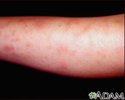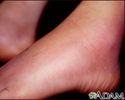Erythema nodosum
Erythema nodosum is an inflammatory disorder. It involves tender, red bumps (nodules) under the skin.
In about half of cases, the exact cause of erythema nodosum is unknown. The remaining cases are associated with an infection or other systemic disorder.
Some of the more common infections associated with the disorder are:
- Streptococcus (most common)
- Cat scratch disease
- Chlamydia
- Coccidioidomycosis
- Hepatitis B
- Histoplasmosis
- Leptospirosis
- Mononucleosis (EBV)
- Mycobacteria
- Mycoplasma
- Psittacosis
- Syphilis
- Tuberculosis
- Tularemia
- Yersinia
Erythema nodosum may occur with sensitivity to certain medicines, including:
- Antibiotics, including amoxicillin and other penicillins
- Sulfonamides
- Sulfones
- Birth control pills
- Progestin
Sometimes, erythema nodosum may occur during pregnancy.
Other disorders linked to this condition include leukemia, lymphoma, sarcoidosis, rheumatic fever, Behcet disease, and ulcerative colitis.
The condition is more common in women than it is in men.
Symptoms
Erythema nodosum is most common on the front of the shins. It may also occur on other areas of the body such as buttocks, calves, ankles, thighs, and arms.
The lesions begin as flat, firm, hot, red, painful lumps that are about 1 inch (2.5 centimeters) across. Within a few days, they may become purplish in color. Over several weeks, the lumps fade to a brownish, flat patch.
Other symptoms may include:
- Fever
- General ill feeling (malaise)
- Joint aches
- Skin redness, inflammation, or irritation
- Swelling of the leg or other affected area
Exams and Tests
Your health care provider can diagnose this condition by looking at your skin. Tests that may be done include:
- Punch biopsy of a nodule
- Throat culture to rule out a strep infection
- Chest x-ray to rule out sarcoidosis or tuberculosis
- Blood tests to look for infections or other disorders
Treatment
The underlying infection, drug, or disease should be identified and treated.
Treatment may include:
- Nonsteroidal anti-inflammatory drugs (NSAIDs).
- Stronger anti-inflammatory medicines called corticosteroids, taken by mouth or given as a shot.
- Potassium iodide (SSKI) solution, most often given as drops added to orange juice.
- Other oral medicines that work on the body's immune system.
- Pain medicines (analgesics).
- Rest.
- Raising the sore area (elevation).
- Hot or cold compresses to help reduce discomfort.
Outlook (Prognosis)
Erythema nodosum is uncomfortable, but not dangerous in most cases.
Symptoms most often go away within about 6 weeks, but may return.
When to Contact a Medical Professional
Contact your provider if you develop symptoms of erythema nodosum.
References
Forrestel A, Rosenbach M. Erythema nodosum. In: Lebwohl MG, Heymann WR, Berth-Jones J, Coulson IH, eds. Treatment of Skin Disease: Comprehensive Therapeutic Strategies. 4th ed. Philadelphia, PA: Elsevier; 2018:chap 75.
Gehris RP. Dermatology. In: Zitelli BJ, McIntire SC, Nowalk AJ, eds. Zitelli and Davis' Atlas of Pediatric Diagnosis. 7th ed. Philadelphia, PA: Elsevier; 2018:chap 8.
James WD, Elston DM, Treat JR, Rosenbach MA. Diseases of the subcutaneous fat. In: James WD, Elston DM, Treat JR, Rosenbach MA, Neuhaus IM, eds. Andrews' Diseases of the Skin: Clinical Dermatology. 13th ed. Philadelphia, PA: Elsevier; 2020:chap 23.
Korsten P, Sweiss NJ, Baughman RP. Sarcoidosis. In: Firestein GS, Budd RC, Gabriel SE, Koretzky GA, McInnes IB, O'Dell JR, eds. Firestein & Kelley's Textbook of Rheumatology. 11th ed. Philadelphia, PA: Elsevier; 2021:chap 124.
Zamore R, Bewtra M, Ogdie A. Inflammatory bowel disease-associated arthritis and other enteropathic arthropathies. In: Firestein GS, Budd RC, Gabriel SE, Koretzky GA, McInnes IB, O'Dell JR, eds. Firestein & Kelley's Textbook of Rheumatology. 11th ed. Philadelphia, PA: Elsevier; 2021:chap 83.
Erythema nodosum associated with sarcoidosis - illustration
Erythema nodosum associated with sarcoidosis
illustration
Erythema nodosum on the foot - illustration
Erythema nodosum on the foot
illustration
Review Date: 8/14/2021
Reviewed By: Elika Hoss, MD, Senior Associate Consultant, Mayo Clinic, Scottsdale, AZ. Also reviewed by David Zieve, MD, MHA, Medical Director, Brenda Conaway, Editorial Director, and the A.D.A.M. Editorial team.












